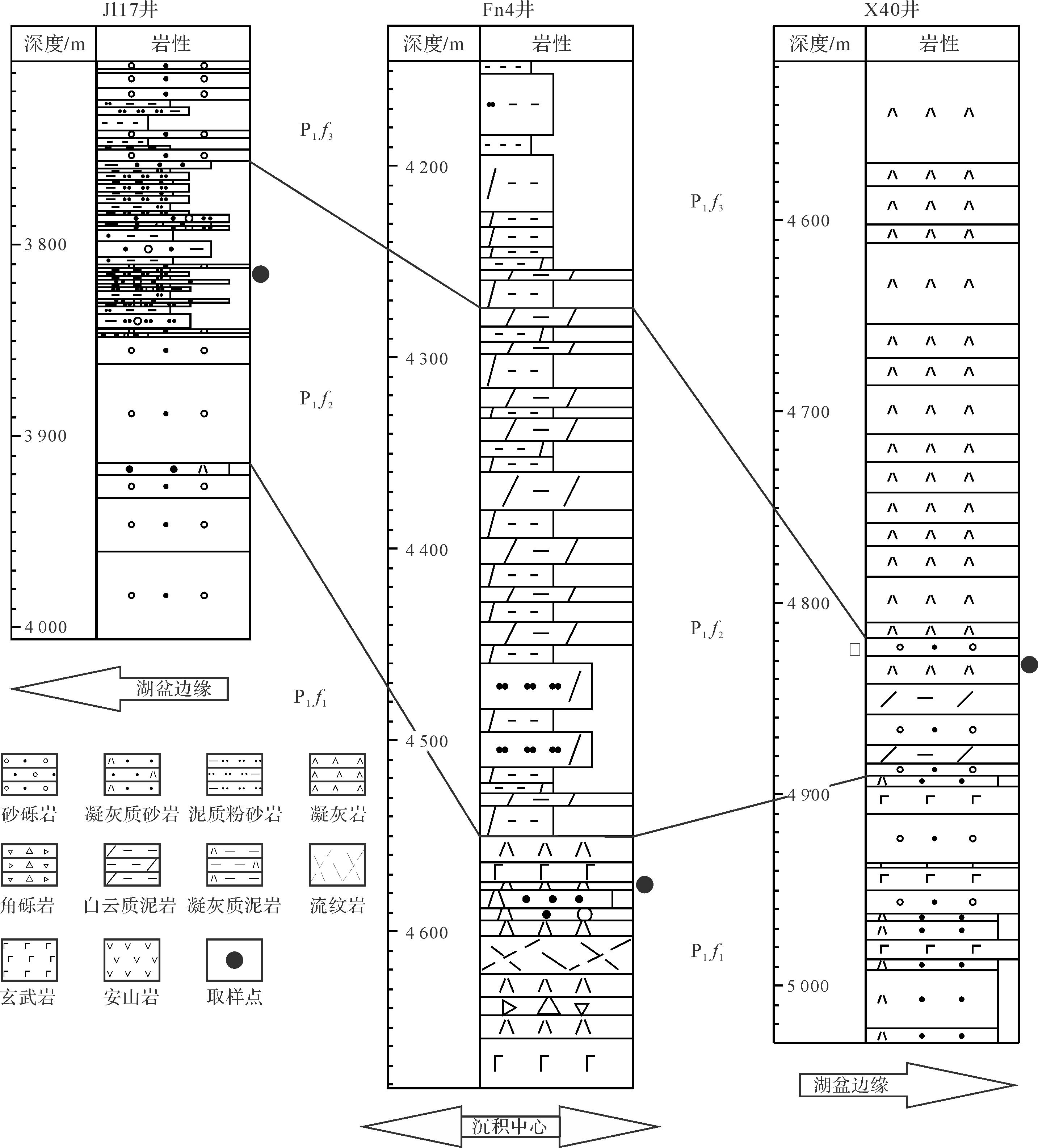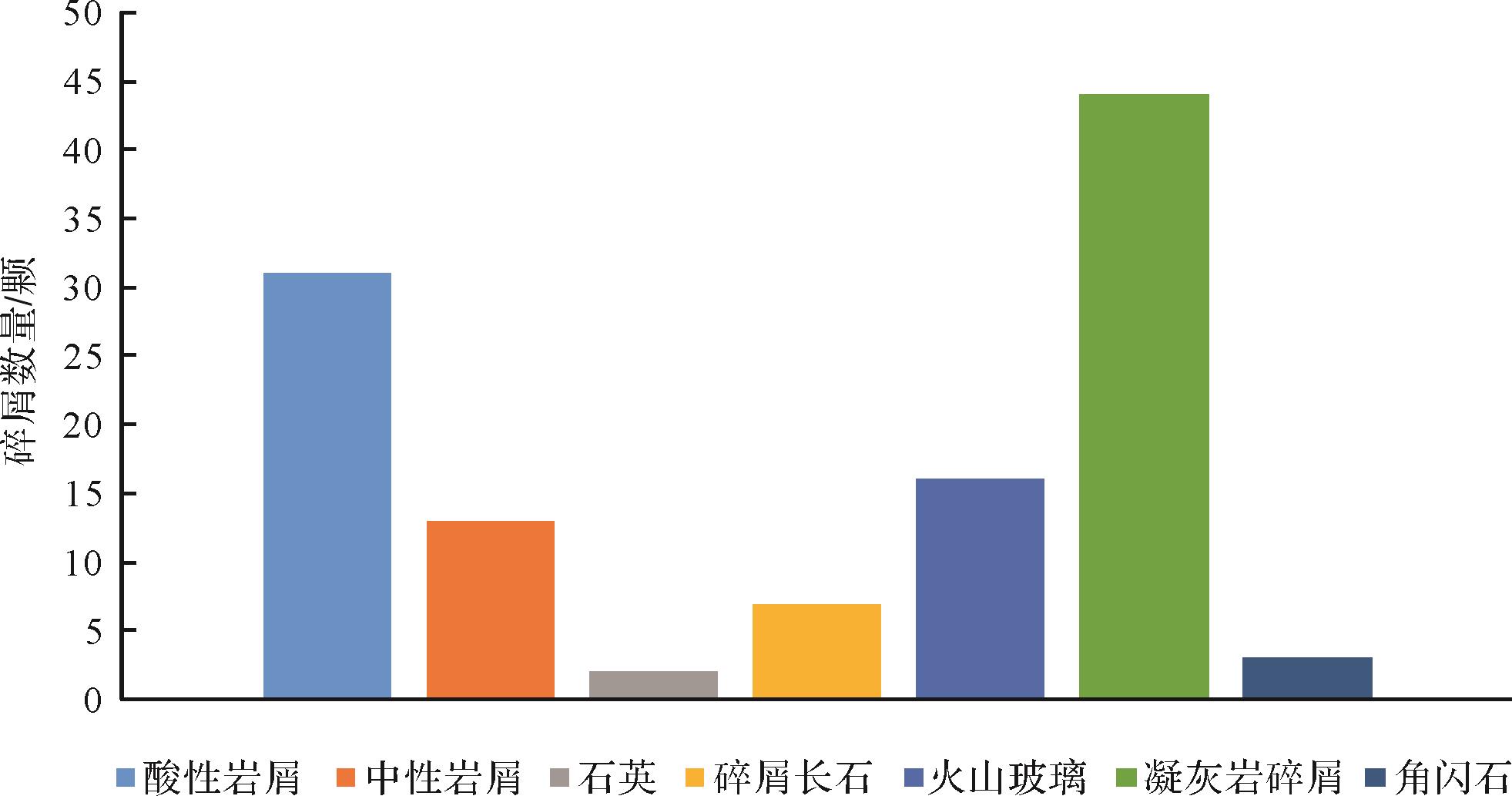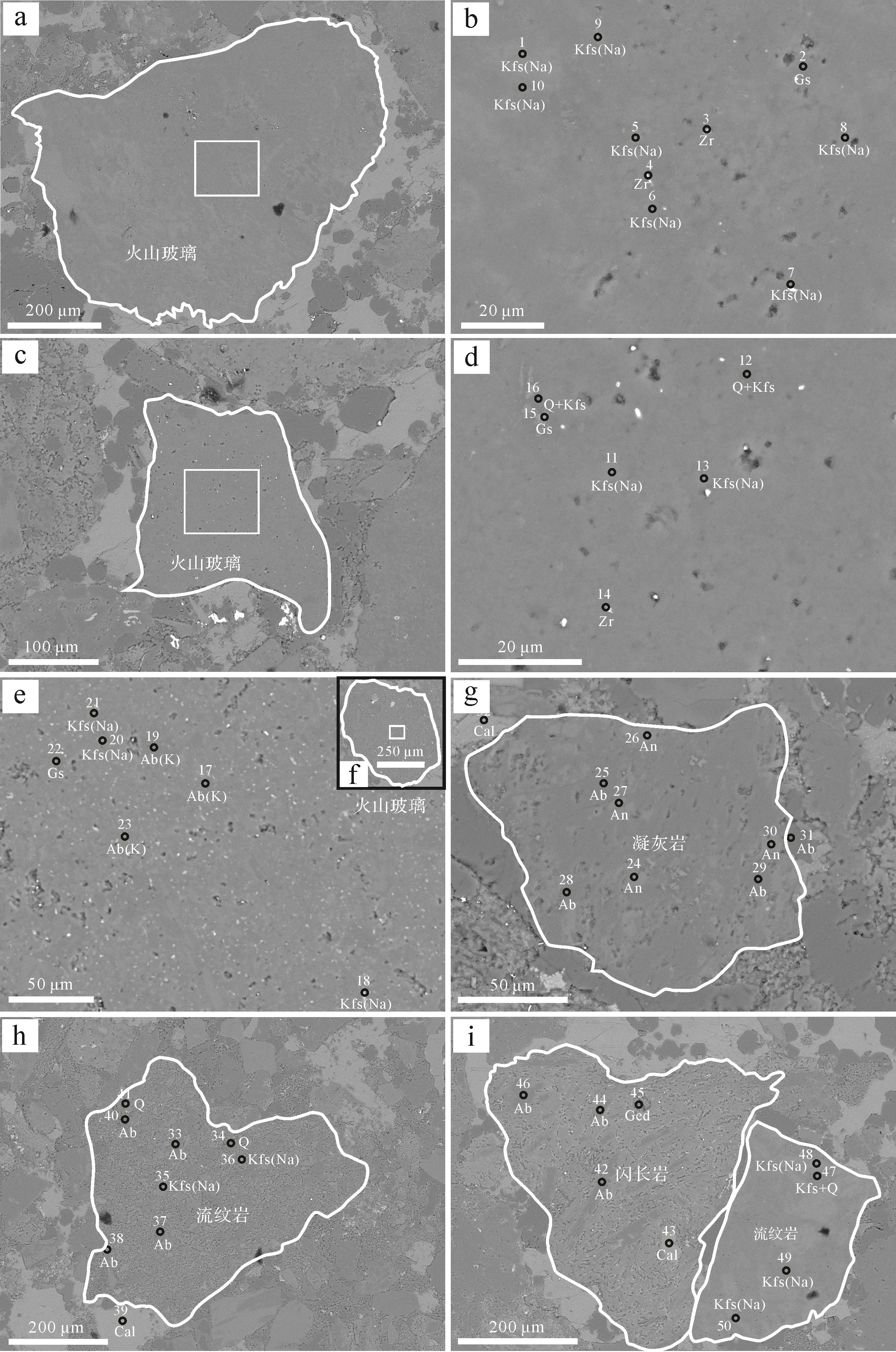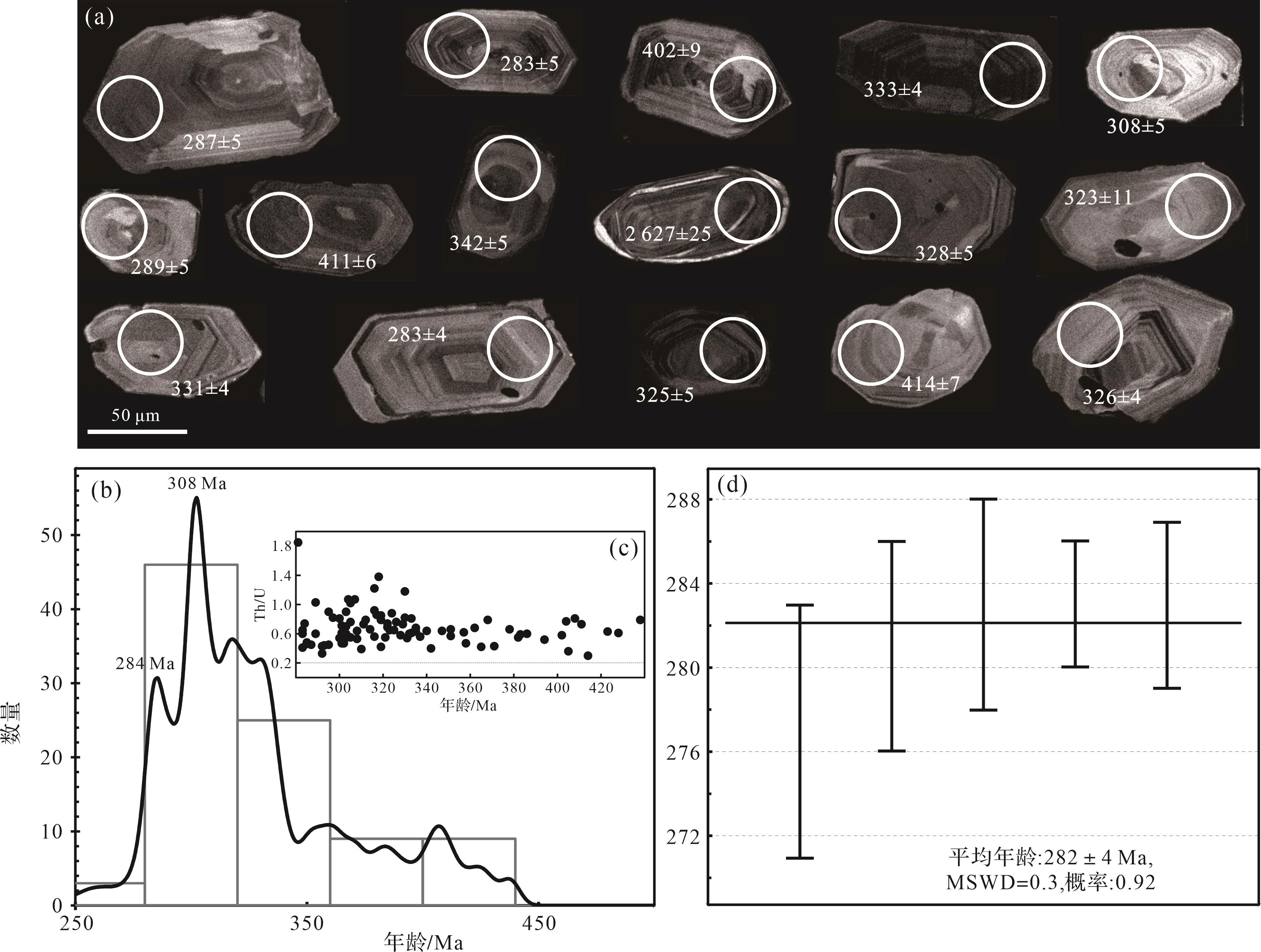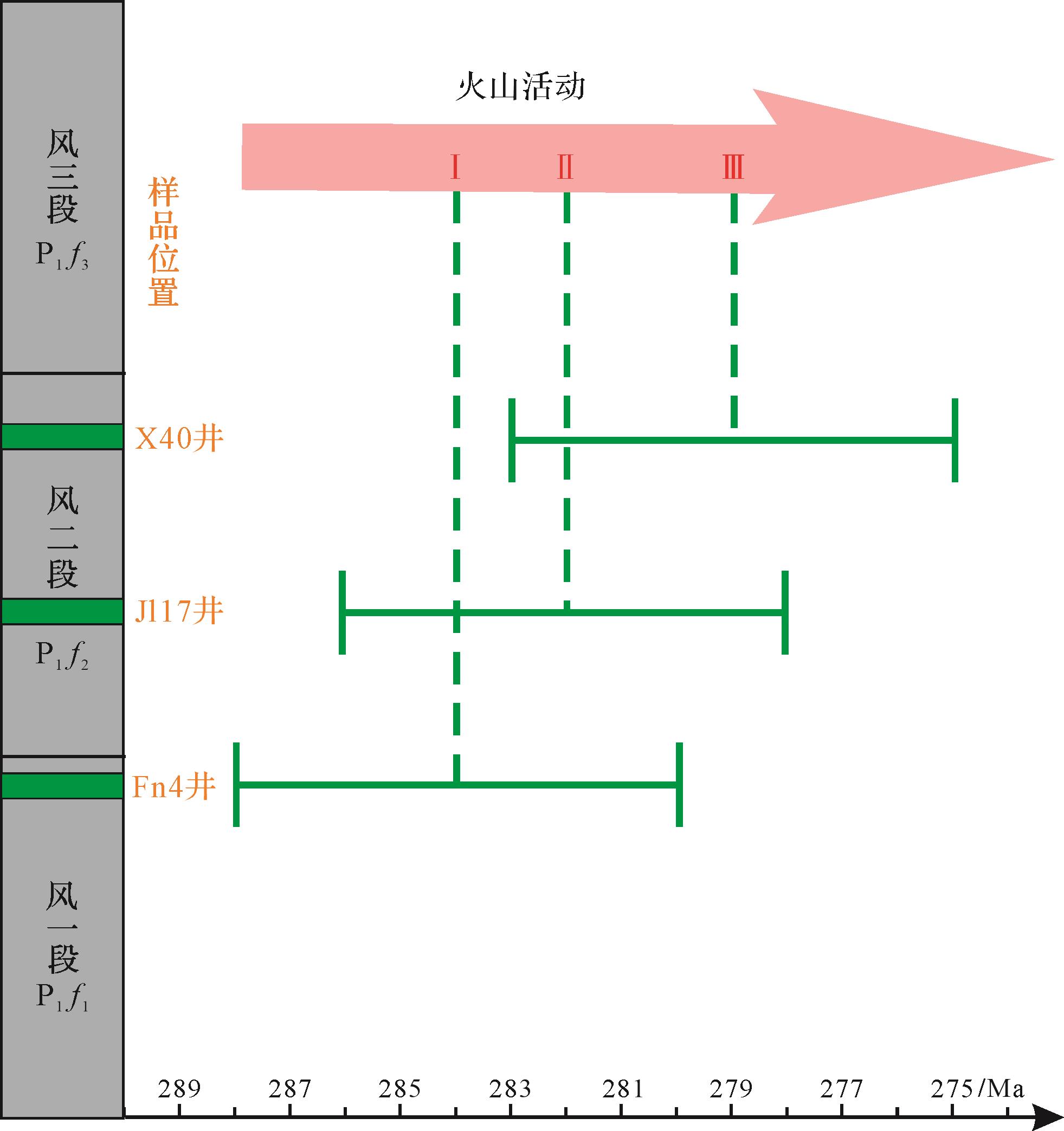HTML
-
在岩浆活动频繁的地质环境中,火山喷发、沉积过程(化学风化、机械破碎、搬运、沉积和成岩)和构造作用(断裂带活动)都可以产生碎屑。这些碎屑沿着火山斜坡,由水系搬运至不同类型的沉积盆地,或者与其他来源的沉积物发生不同比例的混合堆积和相互作用,形成火山碎屑岩、熔积岩、凝灰岩、岩屑砂岩等[1⁃2]。这些火山碎屑物质不仅携带了岩浆活动背景信息,而且可以对携带的锆石进行放射性年代学分析[3⁃4]。在测试获得的年龄直接解释最大的沉积年龄之前,必须证明两个先决条件:(1)测试的矿物结晶时间为最后一次喷发或者略早于最后一次喷发之前;(2)火山活动必须与沉积过程是同时发生的[5⁃6]。
由于准噶尔盆地玛湖凹陷下二叠统风城组碱湖沉积缺乏直接的岩浆活动记录,所以导致以往风城组的沉积年龄数据和地质意义存在争议。最初学者基于风城组与上覆和下伏地层的叠置关系,以及相关古生物证据,将风城组的沉积时限厘定为早二叠世晚期,但是尚不明确其准确年龄[7⁃9]。Wang et al.[10]对碱湖沉积序列底部的蚀变凝灰岩进行LA-ICP-MS锆石U-Pb定年,得出304~296 Ma的年龄区间,认为风城组碱湖序列是300 Ma左右冰期事件的沉积响应[11]。也有学者对风城组碱湖沉积层段的凝灰质岩屑砂岩和凝灰岩开展了LA-ICP-MS锆石U-Pb定年,得出的最年轻年龄峰值为~280 Ma[12⁃14]。准确的年龄时限对于约束玛湖凹陷早二叠世盆地构造演化的动力学机制、古气候背景和油气成藏过程具有重要意义。在收集3件凝灰质岩屑砂岩和凝灰岩样品锆石U-Pb年龄数据的基础上,本文对其中一件凝灰质岩屑砂岩样品进行了详细的岩石学特征分析。通过物源分析确定下二叠统风城组碱湖沉积具有用沉积火山活动的物质来源,并且碎屑锆石U-Pb年龄由底部向顶部逐渐变年轻,指示碱湖同沉积期的火山幕式喷发,更准确地厘定了风城组碱湖的沉积时限。
-
玛湖凹陷是准噶尔盆地最重要的生烃凹陷[15]。现今玛湖凹陷呈北东—南西向展布(图1a),西北缘为扎伊尔山和哈拉阿拉特山,西南缘为中拐凸起、达巴松凸起和陆梁凸起。红车断裂带、克百断裂带和乌夏断裂带控制着二叠系—三叠系的倾斜和剥蚀,以及大型油气系统的分布规律[16]。二叠纪的玛湖凹陷为继承性断陷盆地—坳陷盆地,在晚二叠世—早三叠世发生构造反转[17]。玛湖凹陷充填了超过8 000 m的陆相沉积序列(图1b),其中二叠系风城组是玛湖凹陷的主力烃源岩层系,不仅为上覆源外砂砾岩“大油区”提供物质基础,而且在源内常规砂砾岩油藏和页岩油有序共生,形成全油气系统[18⁃19]。风城组充填了断陷盆地同断陷阶段的沉积序列,自下而上分为三段:风一段(P1 f1)、风二段(P1 f2)和风三段(P1 f3)。玛湖凹陷西北缘边缘相主要为扇三角洲砂砾岩,沉积中心为湖相沉积。风一段主要由底部的中—基性火山岩过渡为白云质泥岩和顶部的富有机质泥岩。风二段主要由富有机质泥岩、白云质泥岩和浊积砂岩组成。风三段由白云质泥岩和富有机质泥岩过渡为扇三角洲砂砾岩[20](图1c)。大量的地球化学研究表明,风一段的古气候条件由半干旱变潮湿,风二段由潮湿变干旱,风三段又转变为半干旱[21]。

Figure 1. (a) Geologic map of West Junggar (WJ) and Mahu Sag withshowing the sample locations of the samples, and their zircon U⁃Pb ages of plutons and ophiolitic mélange zones[13]; (b) Permian⁃Triassic lithostratigraphy and basin tectonic evolution[17]; (c) NW⁃SE trending stratigraphic section of the Fengcheng Formation showing the three members[20], and the drilling core photo of sample Jl17
西准噶尔分为三个构造单元:西准噶尔北部、西准噶尔中部和西准噶尔南部(图1a)。西准噶尔北部包括志留纪—石炭纪博什库尔—成吉思弧和扎玛尔—萨乌尔弧组成。西准噶尔中部泥盆纪—石炭纪海相沉积序列组成。西准噶尔南部寒武纪—早志留世的洋内岛弧和蛇绿混杂岩带组成。整个西准噶尔广泛出露大量的晚石炭世—早二叠世的A型花岗岩[22]。西准噶尔三个构造单元的不同构造背景,以及大量的岩石学和热年代学数据,为早二叠世玛湖凹陷的潜在物源区分析提供了有利条件。
-
本文选取位于扇三角洲前缘浊积岩中的凝灰质岩屑砂岩样品,进行了详细的岩石学特征分析,样品位置见图1c。在河北廊坊宇能岩石矿物分选技术服务有限公司完成了探针片的磨制,在加拿大圣玛丽大学的电子显微镜中心完成SEM扫描电镜观察以及单矿物的能谱分析。抛光样品在镀碳之后,进行扫描电子显微镜观察(Tescan Mira 3 FESEM)和能谱仪分析(30 kV,Oxford Instrument X-Max 80 mm2)。
玛湖凹陷西斜坡报道的3件碎屑锆石U-Pb年代学数据均来源于笔者已发表的文献[12⁃13],取样位置见图2。取自Jl17井的样品位于风二段中部的前扇三角洲的浊积砂体(图1c),取自Fn4井的样品位于风一段顶部的凝灰岩层,取自X40井的样品位于风二段顶部的凝灰岩层。风二段碱湖的沉积中心位于Fn4井附近,厚度向玛湖凹陷西斜坡北东—南西向的湖盆边缘逐渐减薄。由于北东缘的X40井顶部主要为凝灰岩,而沉积中心主要为白云质泥岩,两者不能通过岩性和测井曲线进行对比,所以不能确定是否为风二段顶界。尽管如此,三件年代学样品的取样位置垂向覆盖了风二段碱湖沉积的顶底界,因此可以作为约束风二段碱湖沉积时限的关键证据。
-
从Jl17井获取的砂岩样品为凝灰质岩屑砂岩,分选较差。随机对116个岩屑和单矿物进行了扫描电镜观察和能谱分析,陆源碎屑成分主要包括凝灰岩岩屑和火山玻璃(52%)、中—酸性岩浆岩岩屑(38%),以及少量长石、石英和角闪石(10%)(图3)。
碎屑组分超过50%为凝灰岩岩屑和火山玻璃,粒度介于100~600 μm,棱角状—次棱角状。石英和长石矿物呈他形,指示快速结晶,可见玻屑,锆石发育(图4)。矿物组合指示为中—酸性岩浆喷发的产物,钾长石发生了一定程度的钠长石化(图4b,d,e)。

Figure 4. Representative back⁃scattered electron (BSE) images of textures and minerals of the lithic clasts
岩浆岩岩屑主要包括中性和酸性岩浆岩岩屑(38%)。酸性岩浆岩岩屑主要为流纹岩岩屑,矿物组分主要为石英、钾长石和钠长石(图4h,i)。粒度介于50~500 μm,次圆—次棱角状,钾长石发生了一定程度的钠长石化。中性岩浆岩岩屑主要包括闪长岩岩屑、粗面岩岩屑和安山岩岩屑,矿物组分包括钠长石和角闪石(图4h),粒度介于100~600 μm,次圆—次棱角状。岩屑中的缝洞均被方解石充填(图4h)。
碎屑颗粒间的胶结物主要为钠长石和方解石,钠长石呈自形—半自形,早于方解石充填孔隙(图4g,h)。
-
碎屑锆石形态呈自形—半自形,长边介于60~200 μm,短边介于60~200 μm,见明显的环带结构,Tang et al.[13]对外侧环带开展了LA-ICP-MS定年(图5a)。Th/U比值大于0.2,指示为岩浆锆石(图5c)[13]。碎屑锆石年龄图谱显示,主要峰值集中在石炭纪330~302 Ma,次要峰值出现在二叠纪284 Ma,以及少量志留纪和泥盆纪年龄(图5b)。其中最年轻的五颗锆石的平均年龄为282±4 Ma,与最小年龄峰值一致(图5d)。

Figure 5. (a) Detrital zircon morphology; (b) age pattern; (c) Th/U vs. Age; (d) mean age of the five youngest zircons[13]
3.1. 岩石学特征
3.2. 碎屑锆石与U⁃Pb测年
-
样品的组分主要为岩浆岩岩屑,并且充填了大量的凝灰岩岩屑和火山玻璃,分选磨圆较差,较低的结构和成分成熟度表明为近源、快速堆积(图4)。西准噶尔中部广泛出露石炭系海相沉积序列和花岗岩岩体(图1a),并且准噶尔盆地内部的中拐凸起和陆梁凸起为石炭纪岛弧(330~320 Ma)[23]。广泛出露的花岗岩岩体(330~290 Ma)[22],指示流纹岩岩屑可能是岩体侵入同时期的火山喷发产物,而中性岩浆岩屑为岛弧风化产物(图4)。碎屑锆石年龄图谱显示的石炭纪主要峰值与岩体和岛弧活动年龄一致,表明玛湖凹陷西北缘的西准噶尔中部以及陆梁凸起和中拐凸起为潜在物源区(图5b)。志留系—泥盆系主要出露在西准噶尔北部和西准噶尔中部北缘,表明碎屑锆石年龄图谱中出现的少量志留纪—泥盆纪锆石可能来源于这两个相对较远的物源区(图1a、图5b)。
西准噶尔哈拉阿拉特山残余的玄武岩(283 Ma)和区域广泛剥露的基性岩脉(~280 Ma),反映了早二叠世晚期频繁的岩浆活动[24⁃25]。样品中出现的凝灰岩岩屑和火山玻璃呈棱角状—次棱角状(图4),指示短距离搬运和快速沉积。凝灰岩岩屑和火山玻璃中出现了大量的锆石,碎屑锆石年龄图谱显示次要峰值年龄为284 Ma,表明来源于早二叠世晚期的同火山活动(图5b)。
-
凝灰质岩屑砂岩中出现的大量火山玻璃和凝灰岩岩屑分选差,呈棱角状和次棱角状,其矿物组分自形程度低,指示快速结晶(图4)。虽然钾长石受埋藏作用影响,发生了一定程度的钠长石化(图4b,d),但是没有经历再旋回。锆石年龄图谱的最小峰值以及最年轻的五颗锆石的加权平均值与早二叠世的同沉积火山活动一致(~280 Ma),表明风城组碱湖沉积作用与火山活动等时(图1c)。
虽然前人在风城组底部的凝灰岩序列中,报道了~300 Ma的锆石LA-ICP-MS测试年龄[7],但可能是与花岗岩岩体侵位同时期火山活动相关的凝灰岩。报道的凝灰岩蚀变严重,而且风城组的孢粉组合特征指示为早二叠世晚期[9],所以不能确定风城组底部以下的凝灰岩层是否与碱湖沉积存在沉积间断。碱湖沉积中心发育凝灰岩,在风一段底部(Fn4)和风二段顶部(X40)报道了两件样品的碎屑锆石年代学结果,显示物源与本文测试样品的结果一致,并且最年轻的五颗碎屑锆石平均年龄分别为284±4 Ma和279±4 Ma[12]。三件样品最年轻的五颗碎屑锆石平均年龄由底部向顶部逐渐变年轻,指示早二叠世的火山幕式喷发(图6)。

Figure 6. Vertical distribution of the mean age for the five youngest detrital zircons in three tuffaceous samples
在早二叠世的干旱气候条件下,具有半地堑结构的湖盆发生扩张,并且充填了湖侵序列,指示正断层活动创造的可容纳空间大于沉积物供给速率,在湖盆的欠充填阶段以碱湖沉积为特征[17,21]。在碱湖沉积序列中识别了大量横向可追踪、垂向重复出现的软沉积物变形构造,认为是边界正断层诱发地震活动的沉积响应[20]。因此,碱湖沉积的构造背景为断陷盆地的同断陷阶段,构造活动异常活跃。大量的研究表明,在同断陷阶段往往频繁发生火山活动,并且锆石的结晶时间与喷发时间相近[26]。因此,这三件样品获得的最年轻的五颗碎屑锆石平均年龄可以作为碱湖的沉积年龄,时间跨度大约为5 Ma,与旋回地层学标定的天文时间尺度吻合[27]。综上所述,玛湖凹陷风城组碱湖沉积的时限为284~279?Ma。
4.1. 物源分析
5.2. 风城组碱湖沉积时限
-
(1) 玛湖凹陷下二叠统风城组的凝灰质岩屑砂岩样品的组分包括凝灰岩岩屑和火山玻璃(52%)、中—酸性岩浆岩岩屑(38%),少量石英、长石和角闪石矿物(10%),表明早二叠世同断陷演化阶段的同沉积火山活动为主要物源区,西准噶尔北部、中拐凸起和陆梁凸起的岛弧序列,以及西准噶尔中部的泥盆系—石炭系海相火山—沉积序列为次要物源区。
(2) 三件凝灰岩样品最年轻的五颗碎屑锆石平均年龄由底部向顶部逐渐变年轻,并且与区域岩浆活动的时限一致,表明岩浆幕式喷发的时间与沉积年龄一致,风城组碱湖沉积的时限为284~279?Ma。
(3) 在利用火山碎屑岩或者凝灰质岩屑砂岩中最年轻的五颗碎屑锆石平均年龄约束沉积年龄之前,必须满足两个先决条件:①可以确定火山幕式喷发的时限;②火山活动和沉积作用是等时的。风城组是实践该理论的天然实验室,具有广泛应用价值。
测试点 SiO2 TiO2 Al2O3 FeO MnO MgO CaO Na2O K2O P2O5 ZrO2 1 66.28 16.49 0.94 6.85 9.15 2 69.58 16.11 0.78 10.72 2.81 3 56.90 13.92 0.67 1.06 8.81 3.18 15.45 4 57.14 14.04 0.90 0.57 8.93 3.09 15.33 5 66.32 16.62 1.35 8.63 7.08 6 66.77 17.43 0.87 9.84 5.08 7 42.52 12.36 0.30 8.45 1.84 8 66.46 16.86 0.87 7.50 8.31 9 60.79 15.84 0.68 12.69 6.19 10 77.74 10.10 0.57 5.14 5.94 11 68.38 15.23 1.33 7.11 7.96 12 91.25 4.41 2.25 2.09 13 67.88 13.77 3.91 0.68 6.20 7.56 14 64.24 8.49 0.86 4.43 3.94 18.03 15 72.31 9.37 3.31 0.90 0.34 7.77 3.97 16 83.89 7.72 0.61 3.63 4.16 17 65.98 19.20 0.96 12.82 1.03 18 56.56 4.69 15.79 2.30 3.86 5.36 9.40 2.04 19 65.38 18.58 0.51 13.41 2.13 20 55.05 8.05 15.99 5.09 1.10 7.22 6.80 0.69 21 63.70 0.81 18.56 0.76 1.42 8.36 6.39 22 64.05 0.43 18.46 0.60 1.20 10.64 4.63 23 64.84 19.77 2.66 11.23 1.49 24 59.74 24.10 6.30 9.25 0.61 25 64.49 20.32 0.81 13.34 1.04 26 56.87 25.56 0.42 7.87 7.95 1.32 27 59.72 23.54 0.34 6.23 9.44 0.73 28 66.40 18.94 0.32 14.34 29 67.27 18.93 13.79 30 58.45 24.02 0.36 7.62 8.59 0.97 31 65.17 20.89 13.94 32 3.61 0.88 95.50 33 67.02 18.58 14.40 34 100 35 64.37 18.27 0.33 0.81 5.40 10.81 36 64.40 17.81 6.56 11.23 37 67.82 18.27 13.64 0.28 38 66.70 19.22 0.50 13.58 39 3.79 0.71 95.50 40 61.75 21.02 0.65 0.66 15.41 0.52 41 92.43 3.96 1.68 1.93 42 66.23 19.17 0.39 13.64 0.58 43 1.03 1.50 97.47 44 64.10 21.05 0.50 1.65 11.83 0.86 45 42.47 14.99 16.90 23.56 1.61 0.46 46 66.36 18.89 0.28 14.46 47 80.95 9.90 0.53 5.65 2.96 48 66.99 15.85 1.41 6.65 9.10 49 77.00 11.51 0.68 6.90 3.91 50 65.95 16.83 0.94 7.10 9.18 Table 1. Analysis results of major elements in 50 minerals (%)




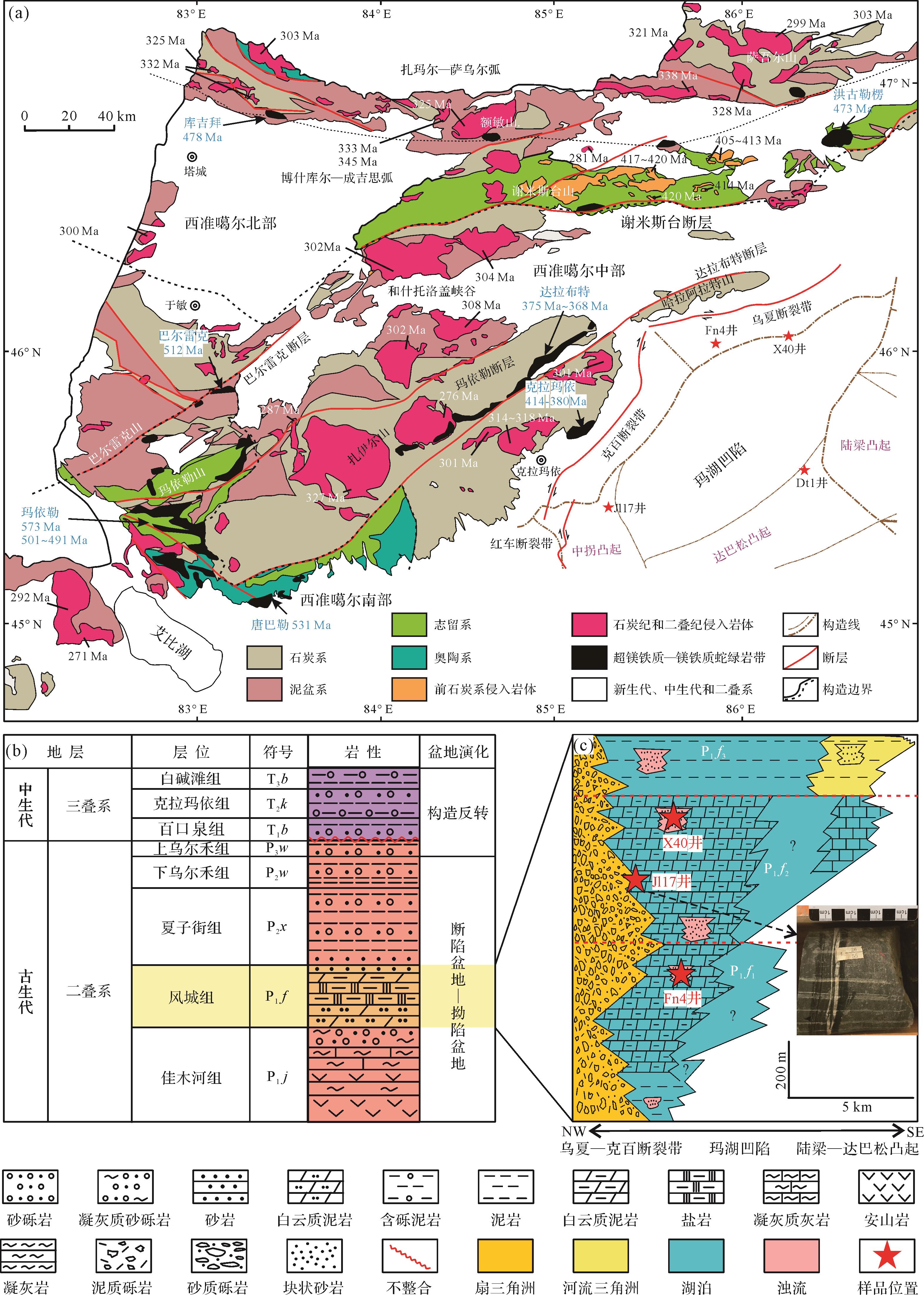




 DownLoad:
DownLoad:
